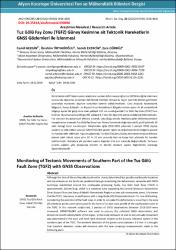Tuz Gölü fay zonu (TGFZ) güney kesimine ait tektonik hareketlerin GNSS gözlemleri ile izlenmesi
Citation
Gezgin, C. , Tiryakioğlu, İ. , Ekercin, S. & Gürbüz, E. (2020). Tuz Gölü Fay Zonu (TGFZ) Güney Kesimine ait Tektonik Hareketlerin GNSS Gözlemleri ile İzlenmesi . Afyon Kocatepe Üniversitesi Fen Ve Mühendislik Bilimleri Dergisi , 20 (3) , 456-464 . DOI: 10.35414/akufemubid.690886Abstract
Günümüzde aktif fayların yakın alanlarına kurulan deformasyon ağlarının GNSS tekniği ile izlenmesi
sonucunda depreme ait zamanı belirlemek mümkün olmasa da faylar üzerinde biriken gerilmeler
yardımıyla muhtemel deprem konumları tahmin edilebilmektedir. Orta Anadolu Neotektonik
Bölgesini, Konya-Eskişehir ve Kayseri-Sivas Neotektonik Bölgeleri olmak üzere iki alt neotektonik
bölgeye ayıran bir geçiş zonu olan yaklaşık 220 km uzunluğundaki Tuz Gölü Fay Zonu (TGFZ)’nun
kırılması durumunda büyüklüğü (M) yaklaşık 6-7 olan bir depreme sebep olabileceği bilinmektedir.
Fay zonunun bu potansiyeli dikkate alınarak, bulunduğu alanda meydana gelen deformasyonların
hesaplanması amacıyla Tuz Gölü Fay Zonu’nun Güney Kesiminde doğu-batı yönlü profil şeklinde 24
adet nirengi tesisi kurulmuştur. Oluşturulan ağda 2018-2019 yıllarında 3 periyot GNSS ölçüsü
yapılmış ve elde edilen sonuçlar GAMIT/GLOBK yazılım takımı ile değerlendirilerek bölgenin güncel
hız haritası elde edilmiştir. Yapılan çalışmada, Tuz Gölü Fay Zonu Güney kesiminde Avrasya referans
sistemi sabit olmak üzere yıllık 10 ile 35 mm arasında batı ve kuzey batı yönünde bir hareket
belirlenmiştir. Noktalara ait standart sapma değerleri 2-6 mm arasında değişmektedir. İlerleyen
yıllarda yapılan yeni kampanya ölçüleri ile birlikte standart sapma değerlerinin azalacağı
düşünülmektedir. Although the time of the earthquake could not be clearly determined but possible earthquake locations
and the stresses on the faults can predicted through monitoring the deformation networks with GNSS
technique established around the earthquake producing faults. Tuz Gölü Fault Zone (TGFZ) is
approximately 220 km long, which is a transition zone separating the Central Anatolian Neotectonic
Zone, Kayseri-Sivas and Konya-Eskişehir Neotectonic Regions as two sub-neotectonic zones, it is known
that the TGFZ, may cause an earthquake with a magnitude (M) of approximately 6-7 in case of breaking.
Considering this potential of the fault zone, in order to calculate the deformations occurring in the area
24 reference points were constructed in the form of an east-west profile of the southeastern part of
the TGFZ. In this network established, 3 periods of GNSS observations between 2018-2019 were
measured. GAMIT/GLOBK software was used to process the collected GNSS observations and
determine recent velocity fields of the region. In the study, between 10 and 35 mm annually movement
was determined in the west and north west direction relative to the Eurasia reference system in the
southern part of the TGFZ. The standard deviation of the points varies between 2-6 mm. It is thought
that standard deviation values will decrease with the new campaign measurements made in the
following years.
Source
MakaleVolume
20Issue
3URI
https://doi.org/10.35414/akufemubid.690886https://dergipark.org.tr/tr/download/article-file/1172623
https://hdl.handle.net/11630/9670
Collections
- Cilt 20 : Sayı 3 [20]



















